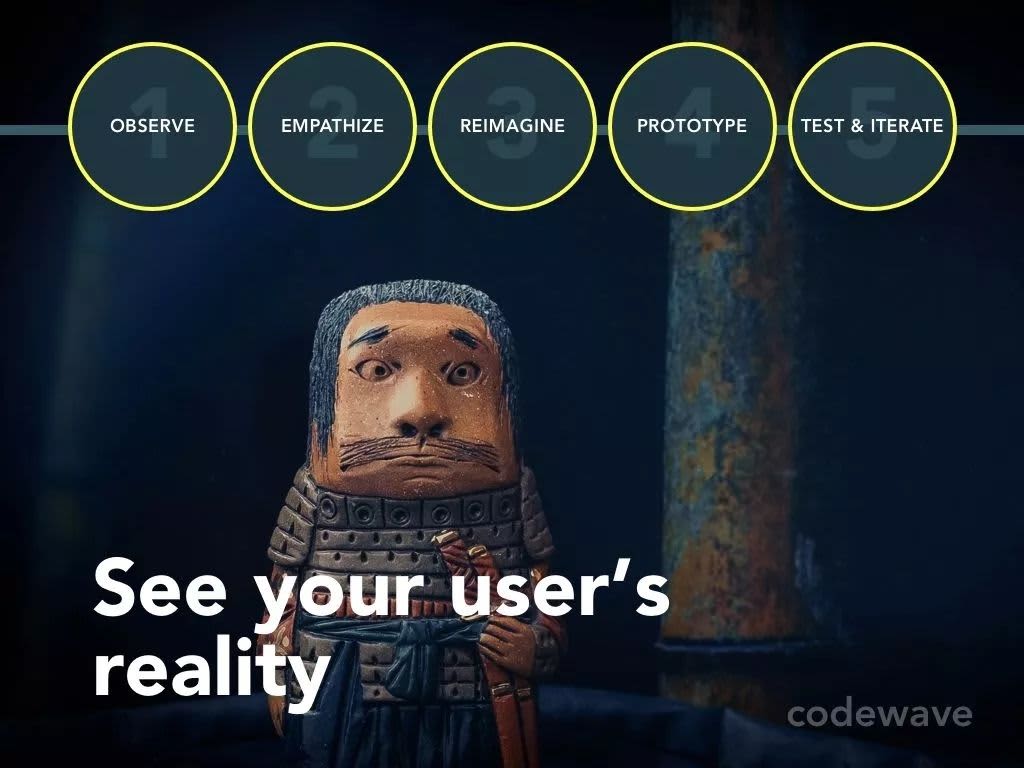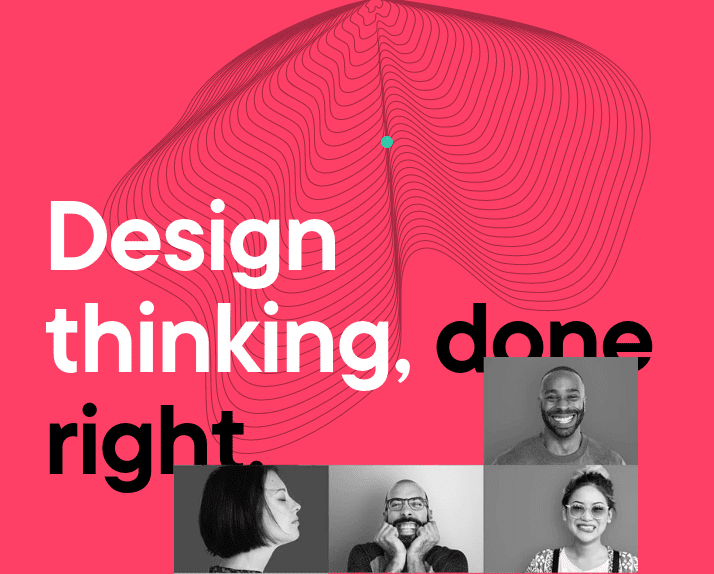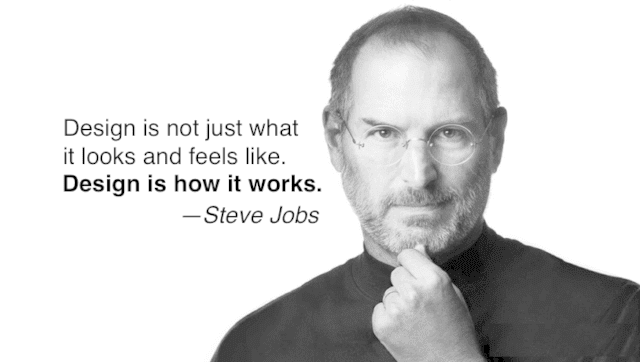Design Thinking: A human-centric approach to solving society’s problems, experimentally

Design Thinking Stages
Companies are driving an ROI of 85% by investing in design thinking.
Every company?
Nope.
The effectiveness with which your company adopts, embraces, executes design-thinking practices highly influences the outcomes.
At Codewave, we’ve helped 300+ organizations mobilize new growth engines with our design-thinking practices. We have seen companies skyrocket, and we have also seen a few go downhill too.
If you’re new to this buzzword you must be wondering “What the heck is design thinking?”
Chill, stay with us. Read this insight to gain a solid understanding of the foundational pillars of design-thinking, and the organizational culture to make it a success.
What is Design Thinking?

- Design Thinking at its core is humanizing products, services, and processes. It’s an approach where everything you do to solve a problem starts by empathizing with the end-users & other stakeholders.
- Design thinking is a “healthy middle ground of problem-solving”. What does that mean? Design thinking isn’t entirely based on emotion, intuition, or business acumen. Nor does it rely primarily on analytics, science, and logic. It’s a fusion of the best of both these worlds.
- It’s an enabler of innovation and transformation as it encourages us to seek out and welcome new, unique, and often unconventional viewpoints.
At Codewave to improve the success probability of an app development project, we adhere to an iterative 5D approach- Discover, Define, Design, Develop, and Deploy. Design-thinking principles are applicable to each of these.
In the next few sections, we shall dive deeper into the design-thinking approach. By the way, do read the insight by Vidhya Abhijith, co-founder & design head at Codewave, where she talks about the 4 steps to practice human-centered design.
How App UI/UX and Design Thinking Are Related?

Design is not just how it looks and feels. Design is how it works. -Steve Jobs
What is the first name that pops up in your mind when you think of mobile, design, and UI/UX? For me, it’s the one and only Steve Jobs. And he said it aptly, “Design is not just what it looks and feels like. Design is how it works.”
APP UI/UX and design thinking go hand in hand. As an entrepreneur when we are designing apps, our goal is to first solve the core problem and then maximize growth and minimize business bottlenecks.
To maximize app growth it’s important that we deliver value to our app users, make the app accessible, usable, navigable, exciting, secure, and fun.
To minimize business bottlenecks, eliminate or improve anything that doesn’t work in favor of your app. It could be your tech stack, organizational structure, operations, office culture, your app’s design responsiveness, or some of the redundant app features/functionality, etcetera.
Now, design thinking is a framework that helps you design your apps in a way that your app scores high on
- Aforementioned UI/UX parameters i.e., usability, accessibility, intuitiveness, credibility, premium feel, and
- The factors influencing business agility i.e., scalability, feature releases, security, etcetera.
Cool, I expect by now you got some fuzzy idea about what design thinking is, and what it can help you achieve. Now, let’s get to the core.
Principles Of Design Thinking

Design Thinking Process
Design thinking starts as soon as your innovative idea sprouts up in your head. As soon as you brainstorm to solve a problem, or maybe many, you are practicing the design thinking approach.
What? Yes.
You found a problem worth solving. Aren’t you empathizing with someone else to solve their problem? Or maybe, you are empathizing with yourself to solve your problem. And EMPATHY is one of the core principles of design thinking.
To implement your idea, you tend to define the problem you are solving, you profile your target customers, you plan for product features or services verticals, etcetera. This is the second important design thinking principle i.e., DEFINE.
You may argue that it is a natural process. How is this design thinking?
That’s the catch.
Of course, it’s natural. But we also have the natural tendency to deviate and lose our focus, get distracted towards inefficient fancy channels/approaches/practices, etcetera. Design thinking is a framework to effectively be human-centric while meeting business goals.
Here’s are the five non-linear, iterative principles of the design thinking process:
Empathize
Empathizing at its core is thoroughly understanding someone else. For app development projects, it means understanding your users in and out.
When you empathize effectively,
- you understand the world that they live in,
- you can theoretically feel their experiences, or
- you develop an understanding of the environmental factors influencing their thought-process, actions, lifestyle, etcetera.
When you successfully crack this, you automatically empathize with your target audience. And as soon as you empathize with your target audience, you interpret the world as they do.
This enables you to understand their:
- Problems & Frustrations
- Behaviors & Emotions
- Strengths & Motivations
- Needs & Aspirations
- Impulses & Desires
- Daily Habits
- Hidden Wants
- Hidden fears / insecurities
It will sound like anyone can empathize, but it is not that easy. Though, I do wish it was true as then very few apps would fail.
The pre-requisite for empathizing is having observational, analytical, and logical reasoning skills. Also, you need to be highly self-aware. We all have biases, preconceived notions, thought processes, ideologies, and belief systems. All these may make you a strong empathizer or a poor one. A good design thinker needs to be a strong empathizer. And unless you are highly self-aware, your biases, beliefs, thought-process may negatively influence your empathizing abilities.
Strong empathizing skills enable you to develop highly personalized apps for your target user base. You don’t act, design, develop, or include a feature in your app solely based on assumptions, instead, you act post validating your ideas by empathizing with the end-user. And this obviously improves the value your app delivers and subsequently enhances the usability of your app.
Empathizing is a foundational pillar of design thinking but it’s barely a one-time effort, instead, it’s an ongoing process. In fact, all the principles of design-thinking are iterative in nature. Design thinking promotes continuous feedback loops.
Define
Now that you have data on your users, you got to extract some value out of it. From UI/UX perspective, the best way to utilize this data is to synthesize all the gathered information into actionable problem statements.
This reminds me of an example by Simon Sinek:
If you’re standing in one corner of a closed room, and you are asked to move to another corner, then you might end up wandering from one corner to the other without actually ever knowing which corner you are supposed to reach. But if you name the corners and someone asks you to go from corner 1 to 3, most probably you will successfully bypass even an obstruction between the corners.
Why am I sharing this example?
It’s because you need to build the right set of actionable questions, to solve the right problems.
Having goal clarity is crucial for solving the right problems. And synthesizing the observed data is highly effective in devising the right set of questions to define your problem statement(s).
A clear human-sensitive problem statement would help you effectively ideate human-centric solutions. As design thinking is non-linear, while you’re attempting to narrow down on problem statements, you might feel the need for little more observational data, and you may need to re-observe your subjects (target user group).
“Based on your observation of users, you define the needs that are unfulfilled, so your business can create value, for which people are ready to pay.” – Vidhya Abhijith
Ideate
The ideation phase plays a major role in deciding the innovative quotient of your solution. The effectiveness of the ideation phase in design thinking is highly dependent on
- how effectively you have empathized with your target group, and
- how effectively you have defined your problem statements.
Ideation is to bring out solution-oriented ideas for all possible permutations and combinations of your defined problem statements, and user profiles. We have a few popular techniques to bring the widest range of ideas catering to different problem statements:
- Brainstorming
- Brain dumping
- Crowdstorming
- Gamestorming
- Roleplay
- Storyboarding
- Brian walking
- Scamper
- Mindmapping, etcetera.
Our design team invests heavily in the ideation phase to come up with some of the worst possible design thoughts and some of the best possible unconventional, futuristic, out-of-the-box ideas. The goal is to
- have a 360-degree view of what you are building, so that you build an effective solution and not just another fancy solution that fails to solve the problem, or fails to deliver value
- know what’s good and what’s bad so that you can pick the right ideas and kick the bad ones
It’s highly important and critical to not judge ideas in the ideation phase while participants are coming up with ideas. Instead appreciate the participation. This is a necessity so that people don’t hold back their ideas and feel motivated to contribute their perspectives.
Again, while ideating you may discover certain aspects that you missed in the observe, or define stage. We should be flexible to revisit earlier stages as many times as necessary. In fact, we may sometimes need to parallely execute two or more design thinking phases.
Prototype
Experiment. Experiment. And experiment.
Developing prototypes is the fourth principle of design thinking, and this also helps you fine-tune the results of the aforementioned principles i.e., Empathize, Define, and Ideate.
The goal behind developing prototypes is to build the bare minimum working product to be used by a very small group of target users, record their interaction with the product, observe user behavior, and measure the effectiveness and performance of your solution. And then utilize the insights gained from the prototype experiment as a feedback loop to the earlier phases of design thinking. Iterate this process until you end up with a satisfactory prototype that holistically serves most of your problem statements.
Developing prototypes
- help you avoid launching useless, irrelevant products in the market,
- help you fine-tune the effectiveness of your product and boost its success chances,
- save you a few bucks (sometimes in millions of dollars), and
- saves your most precious gift i.e., time.
The core idea behind this design thinking principle is to experiment, fail, learn, and build solutions that actually solve the problem worth solving.
Test & iterate
Testing is the fifth and final stage of design thinking. The principle here is to thoroughly test your prototypes, find loopholes or improvisation opportunities. You need to loop in the users, the ideators, designers, empathizers, and the prototype developers to evaluate how effective your solution is. This often involves making iterations, alterations, and refinements.
As already pointed a few times, design thinking is a nonlinear approach to building effective solutions. So, it’s not necessary that you have to sequentially go from 1st stage to fifth. You can develop a prototype even before you have ideated the product. Sounds crazy but it has its own benefits-
- you get actual insights into user behavior.
- you can test the core idea at the earliest and find out if it is even worth pursuing
Summing it up!

It’s about diversity!
Our team infuses design-thinking principles into everything that we build at Codewave. Yes, including teams. This helps us filter out any biases, minimize the vulnerabilities, and humanize solutions. In this insight we gave a theoretical overview of the design thinking process and principles i.e., developing human-centric solutions using the 5 phase framework:
- Empathize
- Define
- Ideate
- Prototype
- Test
Where to go from here:
Gain a practical case-study-led insight into the design thinking principles, understand why design thinking matters.
Find out how Codewave’s design-thinking-led intervention can help you build the right solutions for your audience.
Find out how we help redesign your CX to maximize the impact.
Bonus: To help out our clients get a better hold of the design thinking process, we carry out a live hands-on design thinking workshop every month. The only prerequisite for the workshop is that you should know how to use computers. Yes, I know.








